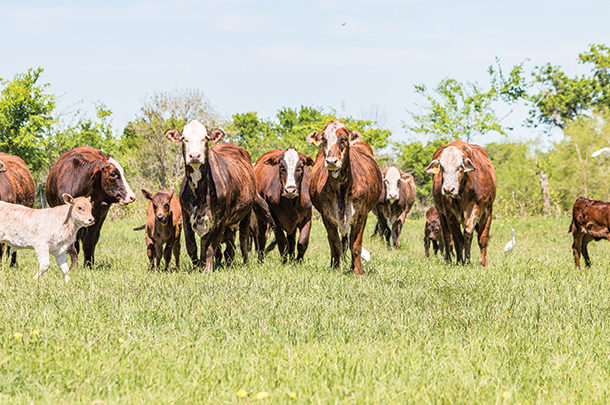Terry Engelken, associate professor at the Iowa State University Veterinary School, adds his own shade when he describes the idea of a closed herd as being possible from a purist standpoint. He also doubts it is often achieved.
Playing the ‘not counting’ game
He says many producers play the “not counting” game. “First, we tend to ignore wildlife,” he said. “From a practical standpoint, it’s almost impossible to keep them out. Then it’s really hard to quantify the types of disease transmission or how easily those pathogens are passed from wildlife to cattle.”
He explains strains of leptospira can be transferred from wildlife to cattle, plus some research also indicates the potential of bovine viral diarrhea (BVD) transmissions, although it is unknown how common this might be. “Deer, raccoons, coyotes, dogs, rats and mice have strains of lepto they can shed, which potentially could cause problems. We really can’t fence it out.”
He says some producers may not count breeding stock. Whether they buy bulls, replacement heifers, pregnant females or the dreaded lone bred cow direct from the auction barn, these are all animals entering the shaky status quo.
Engelken says many farmers in Iowa play “not counting” but operate as farmer feeders bringing in calves to feed. “What are the chances a fence goes down? Now we’ve got stressed feeder calves running with the cows. We have to worry about them spreading viruses, primarily BVD and IBR.”
Many purebred breeders take their cattle to show rings across the country. Some ranch employees own separate cattle. “What kind of risk does that pose? What will get dragged back into the closed herd?”
Micromanaged with continuing vaccinations
Karin Schmid, research and production manager with Alberta Beef Producers, agrees that a truly closed herd from a genetic or biosecurity standpoint requires a tremendous amount of management. “It’s pretty tough to monitor and prevent any contact with other cattle or wildlife under an extensive management system,” she says. “Yes, I do think it’s possible, but it would take an excessive amount of micromanagement. A truly closed herd actually looks more like a swine or poultry operation than a traditional beef operation.”
Both Schmid and Engelken are adamant that producers attempting to maintain a closed herd should never get comfortable enough with health status to stop vaccinating.
“This philosophy should never mean you’re home free as far as vaccinations go,” says Schmid. “If something does manage to break those biosecurity barriers, it’s going to run through those cattle in a far more devastating way than vaccinated cattle. Plus, if those calves are being sold, they can be passing on the disease risk to the next guy in the chain.”
Make a quarantine pen part of the solution
Engelken offers a potential management tool in the form of an isolation pen. “An intersection between a vaccination and biosecurity program is a quarantine pen, where we put any new arrivals.”
He adds it’s imperative as part of any risk assessment to sit down with a veterinarian and create a plan, make health decisions and ask pertinent questions. What tests should be done on new arrivals? Should they be screened for BVD? Are they in a trichomoniasis area? The isolation pen should help secure the answers.
He believes a 45-day quarantine pen allows for numerous benefits and opportunities.
- The 45 days allow time for results of veterinarian tests to be confirmed before new cattle are mixed.
- It permits animals shedding a virus due to transport, feed or other stressors enough time for their immune systems to ramp up and overcome the virus.
- It allows a round of vaccinations, complete with a booster shot, before moving into the herd.
- Lastly, it protects the producer who just can’t resist a good deal on that single bred cow. With their vet’s help running the right tests, she can be quarantined until results are confirmed and she finishes shedding any virus. She should be dewormed, vaccinated and cleaned up before joining the resident herd.
Naïve immunity or preconditioned calves?
Jenna Funk, DVM and associate veterinarian with Metzger Veterinary Services, Linwood, Ontario; and recent Iowa State University researcher, has seen firsthand what can happen when unvaccinated cattle leave a believed closed ranch of origin and make their way to a feedlot.
“If operators are not vaccinating, thinking they are not having exposure, it may work for them while they are still on the home farm – but once those cattle leave, they come in contact with animals from every part of the country. Then they’re at risk of contracting and incubating diseases that, if they had been vaccinated, they would be better able to fight off.”
She says rather than trying to maintain a closed herd, producers would be better off weaning their calves properly, putting together a vaccination program with correctly timed core vaccines of at least two doses. “If you look at preconditioned calves, their chances of being sick are significantly less. And an added benefit is: With calves weaned and vaccinated properly, usage of antibiotics when they get to the feedlots should be less, since those animals should be healthier and better apt to fight off infection without antibiotics.”
Engelken reinforces that no matter how near a herd is to being closed, it’s vital to sit down with a veterinarian and take a cold, hard look at the risks. “Plan and understand the risk of disease introduction and come up with a vaccination and biosecurity program that includes what testing needs to be done to any new arrivals to keep the pathogens out.”
Pursuing a closed herd philosophy is never as black-and-white as locking the farm gate. While reaching this goal may be possible from a purist standpoint, these two dominant colors can easily come under attack by the intrusion of gray. ![]()
PHOTO: Your herd may be “closed,” but don’t forget its interaction with all types of wildlife. Photo by Cassidy Woolsey.
Bruce Derksen is a freelance writer based in Lacombe, Alberta. Email Bruce Derksen.









